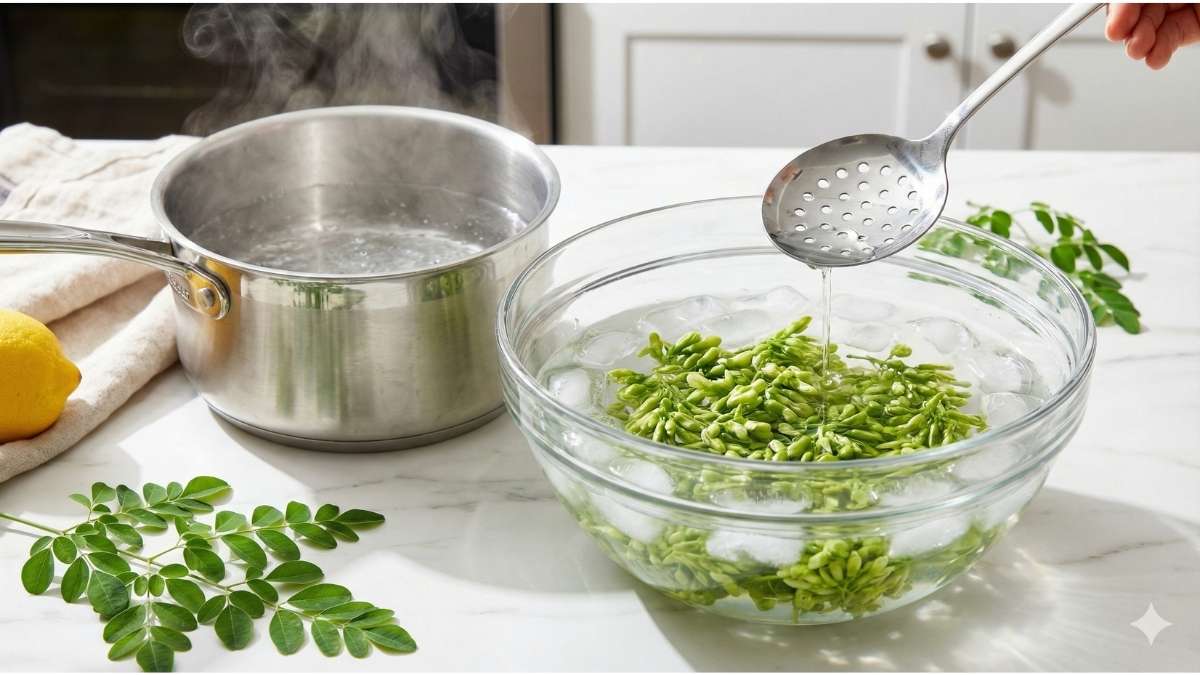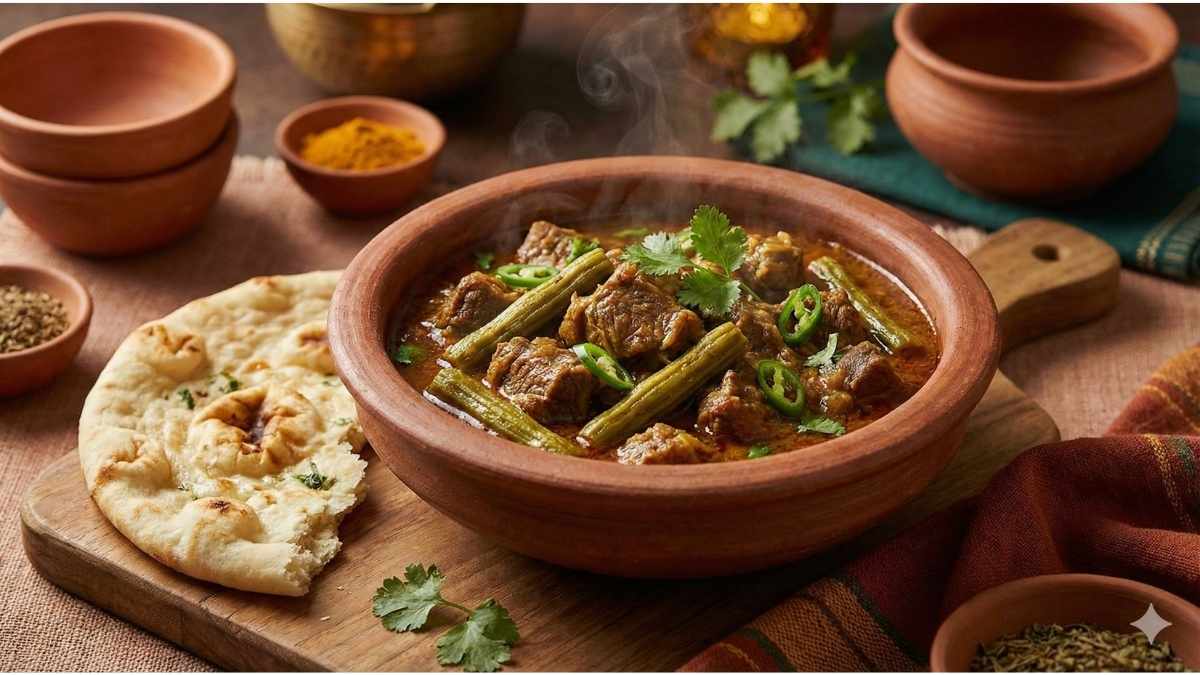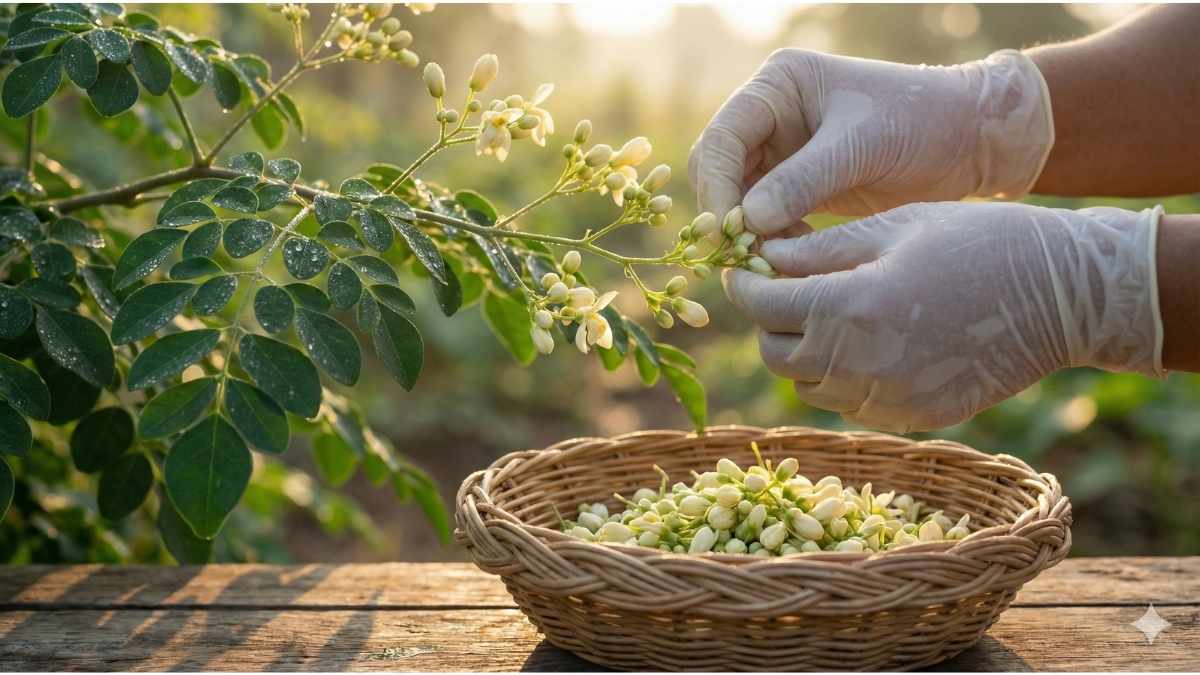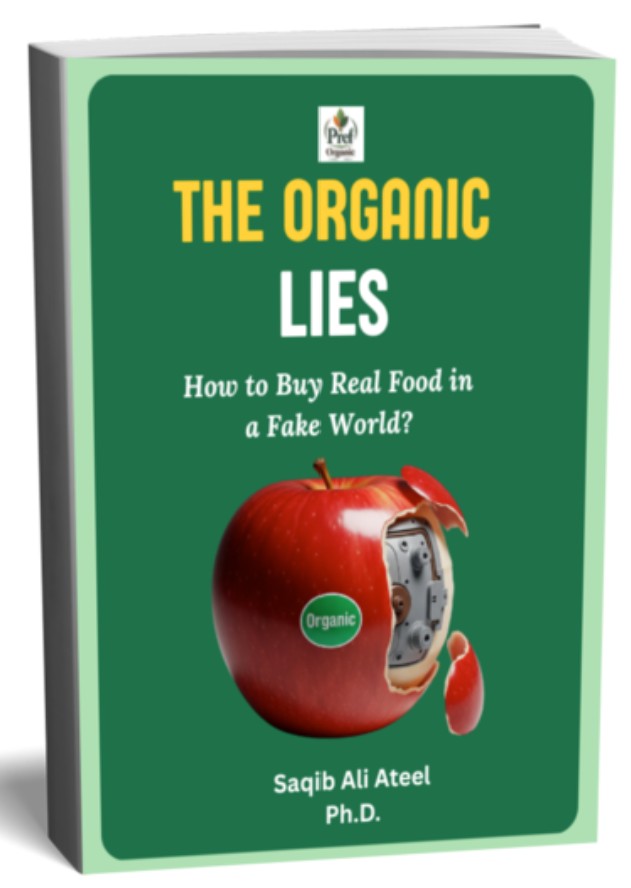From Our Farm to Your Table: The Ultimate Culinary Guide
to Moringa Tree Flowers ❤️
The culinary uses of moringa tree flowers are a secret I’ve cherished since childhood. I remember walking through our fields with my grandfather, a small basket in hand, on a mission to gather the delicate, creamy-white blossoms from the trees that grew so abundantly in South Punjab. For us, they weren’t just pretty flowers; they were a seasonal delicacy, a source of comfort, and a dish my grandmother used to cook. My wife still prepares it with mutton or beef to this day.
Perhaps you have a Moringa tree in your own garden, its branches heavy with these fragrant blossoms, and you’re wondering, “Can I eat these? Are they safe? And will they actually taste good?” You’re a conscious cook, someone who values authenticity and a food-first approach to wellness, and you’re looking for real, hands-on guidance, not just another list of benefits.
During my Ph.D. studies, I have conducted extensive research to bridge the gap from confusion to confidence. In this page, we’ll step away from the supplements and powders and get our hands dirty in the kitchen. I’ll share my family’s traditional methods for harvesting and preparing moringa flowers, along with five authentic recipes that will turn this natural miracle into a star on your dinner table. Let’s get started.
Quick Guide: Harvesting & Cooking Moringa Flowers
- 🌸 Edible & Nutrient-Rich: Moringa flowers are a seasonal delicacy rich in calcium and potassium. They possess a unique, mushroom-like texture and flavor when cooked properly.
- 🧺 Harvesting Strategy: For the best taste, pick young, creamy-white buds in the cool morning. Use a breathable wicker basket or cloth bag to prevent the delicate blossoms from wilting.
- 🧊 The No-Bitterness Hack: Avoid nutrient loss from traditional boiling. Instead, use the Quick-Blanch Method (30-second boil followed by an ice bath) to remove bitterness while locking in color and vitamins.
- 🥘 Versatile Recipes: These flowers are highly adaptable kitchen staples, perfect for savory stir-fries, crispy fritters (pakoras), egg omelets, or traditional mutton curries.
Your Culinary Roadmap to Confidence ✨
Here’s a quick look at the practical knowledge you’re about to gain.
- Harvesting Secrets: Learn my family’s step-by-step method for harvesting moringa tree flowers safely, ensuring you pick them at the peak of freshness and flavor.
- The No-Bitterness Prep Method: Discover the traditional technique for preparing moringa flowers that removes their natural bitterness while preserving their delicate nutrients.
- 5 Authentic Family Recipes: Get exclusive access to five of my favorite recipes, from a simple stir-fry and crispy fritters to the hearty mutton curry of my childhood.
- Year-Round Wellness: Find out what to do when fresh flowers aren’t in season and how to continue enjoying Moringa’s benefits all year long.
The First Question: Are Moringa Flowers Really Edible?
Yes, absolutely! The flowers of the Moringa oleifera tree are not only edible but are considered a delicacy in many cultures across Asia and Africa. When cooked, they have a soft texture and a unique, mild flavor that many people compare to mushrooms, though I’ve always found their taste to be entirely their own.
They are rich in nutrients like calcium and potassium and contain unique bioactive compounds that have been studied for their medicinal properties. But before we can cook them, we must first learn how to gather them correctly.
The PhD Farmer's Guide to Harvesting Moringa Tree Flowers
Safely 🪴
Harvesting these delicate blossoms is a gentle art. Following these steps will ensure you get the best quality flowers without harming the tree.
1. Look for Young, Creamy-White Buds: The best-tasting flowers are those that are young and have not yet fully opened. They should be a vibrant, creamy-white color. Avoid older, yellowing, or wilted blossoms.
2. Harvest in the Morning: The best time to pick the flowers is in the cool of the morning, after the dew has dried but before the sun becomes too intense. This is when they are at their freshest and most fragrant.
3. Be Gentle: Hold the branch steady with one hand and use the other to pinch the clusters of flowers at their base gently. They should come off easily. Never pull or rip the branches, as this can damage them.
4. Use a Basket or Breathable Bag: Collect the flowers in a wicker basket or a cloth bag. A plastic bag will trap moisture and heat, causing the delicate blossoms to wilt and spoil quickly.
5. Inspect as You Go: As you harvest, keep an eye out for any insects or debris. Give the clusters a gentle shake before placing them in your basket to dislodge any unwanted visitors.
The Secret to Delicious (Not Bitter) Moringa Flowers ✨
One thing my grandfather always taught me is that fresh moringa flowers have a slight natural bitterness. The traditional method in my village to remove this is to boil the flowers in water and then discard the water.
However, as a researcher, I am aware that this method also results in significant nutrient loss, as water-soluble vitamins leach out into the discarded water.
Here is my improved method that balances flavor and nutrition:
 The "Quick-Blanch" technique removes bitterness without sacrificing essential water-soluble vitamins.
The "Quick-Blanch" technique removes bitterness without sacrificing essential water-soluble vitamins.The Quick-Blanch Method:
1. Clean the Flowers: Gently wash your harvested flowers in a bowl of cool water to remove any dust.
2. Prepare an Ice Bath: Fill a large bowl with ice and cold water and set it next to your stove.
3. Blanch for 30 Seconds: Bring a pot of water to a rolling boil. Drop the moringa flowers in and let them boil for no more than 30-45 seconds. They will turn a brighter green.
4. Shock in Ice Water: Immediately use a slotted spoon to transfer the flowers from the boiling water into the ice bath. This instantly stops the cooking process, locks in their vibrant color, and preserves more of their nutrients while still removing most of the bitterness.
5. Drain and Use: After a minute in the ice bath, drain the flowers thoroughly. They are now ready to be used in your favorite recipes.
5 Authentic Moringa Flower Recipes from My Family's
Kitchen
Here are five simple, authentic ways to enjoy this incredible ingredient.
1. Simple Moringa Flower & Garlic Stir-Fry
This is the quickest way to enjoy the flowers and is a staple in many South Asian homes. It’s simple, savory, and ready in minutes.
Ingredients:
- 2 cups blanched moringa flowers
- 3-4 cloves garlic, thinly sliced
- 1 small onion, thinly sliced
- 1 green chili, finely chopped (optional)
- 1 tablespoon olive oil or ghee
- Salt and black pepper to taste
Instructions:
1. Heat the oil or ghee in a pan over medium heat.
2. Add the sliced garlic and onion and sauté until they become fragrant and golden brown.
3. Add the green chili (if using) and cook for another 30 seconds.
4. Add the blanched moringa flowers to the pan. Stir-fry for 2-3 minutes, or until the vegetables are tender.
5. Season with salt and pepper, toss to combine, and serve immediately as a delicious side dish.
2. My Grandmother’s Moringa Flower & Mutton Curry (Sohanjna Gosht)
 The hearty flavor of mutton perfectly complements the unique, mushroom-like taste of moringa flowers.
The hearty flavor of mutton perfectly complements the unique, mushroom-like taste of moringa flowers.This is the dish of my childhood. The hearty, savory flavor of the mutton perfectly complements the unique taste of the moringa flowers. It's pure comfort food.
Ingredients:
- 500g mutton or lamb, cut into pieces
- 2 cups blanched moringa flowers
- 2 medium onions, finely chopped
- 2 tomatoes, pureed
- 1 tablespoon ginger-garlic paste
- 1 teaspoon turmeric powder
- 1 teaspoon red chili powder
- 1 teaspoon coriander powder
- ½ cup plain yogurt, whisked
- 3 tablespoons oil or ghee
- Whole spices (2 cloves, 1 cinnamon stick, 2 green cardamoms)
- Salt to taste
- Fresh cilantro for garnish
Instructions:
1. Heat oil or ghee in a pressure cooker or a heavy-bottomed pot. Add the whole spices and let them sizzle.
2. Add the chopped onions and fry until they are a deep golden brown.
3. Add the ginger-garlic paste and sauté for a minute until fragrant.
4. Add the mutton pieces and sear on all sides until browned.
5. Stir in the powdered spices (turmeric, red chili, coriander) and salt. Cook for 2-3 minutes.
6. Add the tomato puree and the whisked yogurt. Cook until the oil begins to separate from the masala.
7. Add 1-2 cups of water, seal the pressure cooker, and cook until the mutton is tender (about 15-20 minutes in a pressure cooker, or 45-60 minutes in a pot).
8. Once the mutton is cooked, add the blanched moringa flowers. Stir gently and simmer on low heat for 5-7 minutes, allowing the flowers to absorb the flavors of the curry.
9. Garnish with fresh cilantro and serve hot with naan or rice.
3. Crispy Moringa Flower Fritters (Pakoras)
These fritters are a perfect appetizer or tea-time snack. The gram flour batter becomes wonderfully crispy, encasing the soft, savory moringa flowers inside.
Ingredients:
- 1 cup blanched moringa flowers, squeezed to remove excess water
- 1 cup gram flour (besan)
- ¼ cup finely chopped onion
- 1 green chili, finely chopped
- ½ teaspoon turmeric powder
- ½ teaspoon red chili powder
- A pinch of asafoetida (hing)
- Salt to taste
- Water to make the batter
- Oil for deep frying
Instructions:
1. In a mixing bowl, combine the gram flour, onion, green chili, turmeric, red chili powder, asafoetida, and salt.
2. Slowly add water, whisking continuously to form a thick, smooth batter (the consistency of pancake batter).
3. Gently fold the blanched moringa flowers into the batter.
4. Heat oil in a deep pan or kadai over medium-high heat.
5. Once the oil is hot, drop spoonfuls of the batter into the oil. Do not overcrowd the pan.
6. Fry the fritters, turning occasionally, until they are golden brown and crispy on all sides.
7. Remove with a slotted spoon and drain on a paper towel. Serve hot with mint chutney or ketchup
4. Moringa Flowers & Herb Omelet
Start your day with a nutrient-packed omelet. The moringa flowers add a lovely, savory depth that pairs beautifully with fresh herbs.
Ingredients:
- 2 large eggs
- ¼ cup blanched moringa flowers
- 1 tablespoon finely chopped onion
- 1 tablespoon chopped fresh cilantro or parsley
- A pinch of black pepper
- Salt to taste
- 1 teaspoon butter or oil
Instructions:
1. In a bowl, whisk the eggs until they are light and frothy.
2. Stir in the blanched moringa flowers, chopped onion, cilantro/parsley, salt, and pepper.
3. Heat the butter or oil in a non-stick skillet over medium heat.
4. Pour the egg mixture into the skillet and cook for 2-3 minutes, or until the edges are set.
5. Gently lift the edges and tilt the pan to allow the uncooked egg to flow underneath.
6. Once the omelette is mostly set, you can fold it in half. Cook for another minute until it is cooked through to your liking.
7. Slide onto a plate and serve immediately.
5. Soothing Moringa Flower Tea
This is a traditional preparation, often used for its calming and medicinal properties. It's a gentle way to consume the essence of the moringa flower.
Ingredients:
- ¼ cup fresh or 2 tablespoons dried moringa flowers
- 2 cups water
- 1 teaspoon honey or a slice of lemon (optional)
Instructions:
1. Bring the 2 cups of water to a boil in a small saucepan.
2. Add the moringa flowers to the boiling water.
3. Reduce the heat and let it simmer gently for 5 minutes.
4. Turn off the heat, cover the saucepan, and let the tea steep for another 5 minutes to allow the flavors and compounds to infuse.
5. Strain the tea into a cup.
6. Stir in honey or add a squeeze of lemon, if desired. Enjoy warm.
The Missing Piece for Year-Round Wellness 🛡️
Enjoying fresh moringa tree flowers is a wonderful seasonal treat that connects us directly to the gifts of the earth. But how do you get these powerful benefits all year round, even when the tree isn't blooming? For daily convenience and consistent potency, the most reliable method is a high-quality moringa supplement.
While the powder is versatile, Moringa Capsules offer a simple, pre-measured dose that fits perfectly into a busy life. However, not all capsules are created equal. To ensure you're choosing a product that is pure, safe, and effective, it's crucial to know what to look for on the label.
To continue your journey, I highly recommend reading my Moringa Capsules: Your Research-Backed Blueprint for Confident, Safe Use. If you're ready to make a choice, you can see how a top brand stacks up against my expert criteria in my review of Rosabella Moringa Capsules.
Conclusion: From a Flower to a Feast 💪
You came here curious and perhaps a little uncertain about the strange and beautiful flowers of the Moringa tree. Now, you are armed with the knowledge of a farmer and the skills of a home cook. You know how to harvest them, how to prepare them to perfection, and you have five authentic recipes to transform them from a curiosity into a delicious, nourishing meal.
You have moved from confusion to confidence, ready to bring another piece of the natural world into your kitchen. I encourage you to try one of these recipes. Experience the unique flavor for yourself, share it with your family, and feel the deep satisfaction that comes from cooking with something you’ve gathered with your own hands.
For those who love to explore further, a review on the Journey of edible flowers from farm to consumer's plate” is a valuable information.

